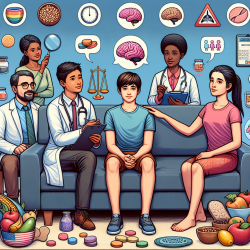Introduction
As a speech-language pathologist with a focus on data-driven decisions, I am constantly seeking ways to improve therapeutic outcomes for children. The recent research article titled "Considerations in Evidence-Based Treatment of Adolescents With Atypical Anorexia Nervosa" provides valuable insights into the treatment of atypical anorexia nervosa (AAN), a condition that is increasingly recognized as a serious eating disorder. This blog aims to highlight key findings from the research and offer practical steps for practitioners to enhance their treatment approaches.
Understanding Atypical Anorexia Nervosa
Atypical anorexia nervosa, as defined in the DSM-5, shares diagnostic criteria with anorexia nervosa but is characterized by significant weight loss in individuals who remain within or above a normal weight range. This condition is as medically concerning as traditional anorexia nervosa, with similar risks such as bradycardia and electrolyte imbalances. The prevalence of AAN is notably higher than anorexia nervosa, making it crucial for practitioners to recognize and address this disorder effectively.
Key Recommendations for Practitioners
- Accurate Diagnosis: Ensure that weight loss and restrictive behaviors are thoroughly assessed to diagnose AAN accurately. This involves collaboration with medical professionals to evaluate medical risks and determine appropriate care levels.
- Family-Based Treatment (FBT): The research highlights the efficacy of FBT for adolescents with AAN. This approach involves family members in the treatment process, emphasizing weight restoration and nutritional recovery as primary goals.
- Addressing Weight Stigma: Practitioners should be aware of weight bias and stigma that may affect adolescents with AAN. Providing education to families and advocating for a supportive environment can mitigate these challenges.
- Collaborative Care: Interdisciplinary collaboration is essential. Psychologists, dietitians, and medical professionals should work together to set target goal weights and monitor progress, ensuring consistent messaging and support for the adolescent.
Encouraging Further Research
While the current research provides a strong foundation, there is a need for further studies to explore treatment efficacy and modifications specific to AAN. Practitioners are encouraged to stay informed about emerging research and contribute to the growing body of knowledge in this field.
Conclusion
By integrating evidence-based practices and addressing the unique challenges of atypical anorexia nervosa, practitioners can significantly improve outcomes for adolescents. The insights from this research are invaluable in guiding treatment approaches and fostering a supportive environment for recovery.
To read the original research paper, please follow this link: Considerations in Evidence-Based Treatment of Adolescents With Atypical Anorexia Nervosa.










